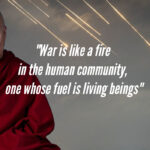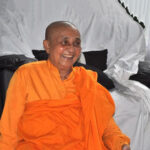
The current leaders of Burma?s 25-year-old human rights movement now speak the language of national security, absolutist sovereignty, and conditional human rights, echoing the language and sentiment of their former captors, the ruling military. The NLD and the democracy opposition have failed to see their own personal and ideological contradictions. Their embrace of conditional human rights and their absolutist reading of sovereignty indicates that they have talked the talk of Buddhism, with its ideal of universal lovingkindness, but have failed to walk the walk. Many student leaders and human rights activists of the 1988 uprisings who spent half their lives behind bars in the notorious military-run Insein Prison as ?prisoners of conscience? are unprepared to extend such human rights ideals to the Rohingya Muslims, a population that the United Nations identifies as one of the world?s most persecuted minorities.
Buddhism, as a religious and philosophical system, has absolutely nothing to say about the political, economic, and cultural organizations that we call nation states. Buddhism is not about people imagining a national community predicated upon adversarial relations but rather about using one?s own intellectual faculties to see through the nonexistent core-essence of self. Yet in Burma, this humanistic philosophy has proven itself indisposed to guard against overarching societal prejudices and their ultranationalist proponents, those Burmese who vociferously profess their adherence to Buddhist faith, practice religious rituals and patronize Buddhist institutions, and then proceed to commit unspeakable atrocities against anyone they imagine to be an enemy of Buddhism, the Buddhist state, Buddhist wealth, Buddhist women, and Buddhist land. Instead of propagating the guiding societal principles of religious tolerance, nondiscrimination, and social inclusion among lay devotees, the influential Buddhist clergy themselves have, in their outspoken criticism and picketing against the Royingya, become an entire people?s most dangerous threat.
Throughout the alien British rule from 1824 to 1948, the Buddhism of colonial Burma contributed to the formation of a common national identity, providing a basis for concerted anti-imperialist efforts among disparate social classes and ethnolinguistically diverse Buddhist communities with conflicting political interests. The current resurgence of racism is a direct result of a half century of despotic military rule. The careful construction of an iron cage?a monolithic constellation of values, an ad hoc ethos?locks in and naturalizes a singular view of what constitutes Burma?s national culture. The dominant population remains potently ethnonationalist, essentializing Buddhism as the core of an authentic Burmese national identity.
For a minority of Burmese Buddhists, the combination of Buddhist nationalism and strong racial distinctions that served as an ideological springboard and a rallying cry against the British Raj is now scorned as a thing of the past. But for many Burmese Buddhists, the same ethnoreligious nationalism that once served the Burmese independence movement has provided an environment in which their racism can flourish.
Buddhist-inspired social forces have proven to be a double-edged sword over the years. In the newly independent post?WWII Burma of the late 1940s, Marxist-inspired revolutionary nationalists led by the martyred Aung San (Aung San Suu Kyi?s father) set out to forge a new multiculturalist, secular, and civic nationalism. In 1948, after Aung San was assassinated by a rival Burmese politician (and less than 90 days after the country?s newly acquired independence), Burma plunged into a long series of armed revolts against the central state. Aung San?s successors gradually abandoned any attempts to secularize Burmese nationalism along the lines of civic nationalism, which would have moved the Burmese away from the premodern provincialist blood- and faith-based view of national identity.
Against this backdrop, the popular racism of the Buddhist majority presents itself as a potent social force that can be appropriated by Burma?s national security state to unify and rally anti-Muslim Burmese citizens. Burma?s state authorities, consisting predominantly of generals and ex-generals, are also generous patrons of Buddhist institutional activities such as dana and pagoda and temple building. These military leaders will continue to feed the masses their opiate?the pretension of Buddhism, with its effect of normalizing human suffering?to the masses, as long as the Buddhists believe that their faith, and not their political economy, promises better rebirth. As one regime official told me, ?The bottom line is, we don?t want any more ?Mus? in our country, but we can?t possibly kill them all.? As a solution, the reformist state leadership has outsourced the job of cleansing its Golden Land to the Rakhine Buddhists.
By Maung Zarni
?
Credit http://www.tricycle.com/feature/buddhist-nationalism-burma?page=0,0
?
?
Maung Zarni is a Burmese activist and scholar. He is a visiting fellow at the London School of Economics and the founder of the Free Burma Coalition.
Image 1: Jonathan Saruk/Getty images. Thousands of unregistered Rohingya Muslim refugees from Burma live next to the registered refugee camp at Kutupalong Refugee Camp, Bangladesh.
Image 2: Thet Htoo/Zuma Press/Newscom. Rakhine men and a Buddhist monk hold handmade spears and watch as a fire burns in Sittwe, capital city of Rakhine State. Two weeks of clashes between Rohingya Muslims and ethnic Rakhine Buddhists left an official death toll at 50, with 58 injured and more than 2,500 houses burned down.
Image 3: Soe Than Win/AFP/Getty/Newscom. Rakhine Buddhist monks pray in Langon, Burma, in June 2012. Several thousand monks took to the streets of Mandalay to protest against a world Islamic body?s efforts to help Muslim Rohingya in strife-hit Rakhine State.
Image 4: Jonathan Saruk/Getty images. An unregistered Rohingya child draws on the wall of a classroom provided by the charity Islamic Relief at Leda Refugee Camp, Bangladesh.
?





